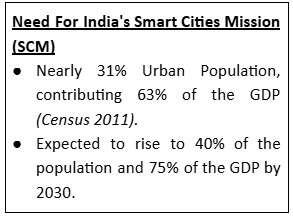Syllabus: GS2/Governance; GS3/Infrastructure
Context
- Despite significant investments in India’s Smart Cities Mission, there are shortcomings particularly in terms of maintenance and sustainability, as recently observed severe flooding in cities like Bengaluru and Pune.
India’s Smart Cities Mission (SCM)
- It aims to address the growing urban challenges by integrating technology and sustainable development into city planning.
- It was launched in 2015 with the goal of transforming urban centers through technology-driven solutions.
- It aimed to enhance infrastructure, improve governance, and create sustainable cities.
- It included area-based development — such as retrofitting, redevelopment, and greenfield projects — and pan-city solutions that leveraged digital tools for efficient urban management.
- It aligns with 15 out of 17 SDGs, focusing on liveability, economic growth, and sustainability.

Operational Framework
- Selection Process: 100 cities were selected through a two-stage competition.
- Implementation: Special Purpose Vehicles (SPVs) handle project execution.
- Centrally Sponsored Scheme: ₹48,000 crore allocated by the central government over five years (₹100 crore per city annually).
- States or Urban Local Bodies (ULBs) need to match funding.
- Additional resources raised via municipal bonds, government programs, and public-private partnerships (PPP).
- Over the years, the mission has sanctioned over 8,000 projects across 100 cities, with an estimated investment of ₹1.67 lakh crore.
- Integrated Command and Control Centres (ICCCs) were established to enable real-time monitoring and decision-making.
Challenges and Concerns
- Maintenance & Sustainability Concerns: Despite the substantial financial commitment, cities like Bengaluru and Pune have struggled with flooding due to inadequate upkeep.
- The lack of clear guidelines for maintaining smart city assets raises concerns about the longevity of these investments.
- Governance and Implementation Issues: The governance model of smart cities bypassed local governments and relied on SPVs, which functioned like private companies.
- Delays and Incomplete Projects: Although the SCM was concluded on March 31, 2025, 7% of projects are still ongoing.
- Many cities have struggled to complete their planned infrastructure upgrades within the given timeframe, leading to uncertainty about their future.
- Financial and Strategic Concerns: SCM has disbursed funds through a grant structure that lacks a cohesive national strategy.
Need for a Long-Term Strategy
- The Smart Cities need to go beyond infrastructure upgrades and embed a culture of maintenance and performance tracking.
- Without proactive governance, cities risk repeating cycles of neglect and reconstruction.
- Expanding Digital Infrastructure: Smart cities need to continue investing in technology-driven solutions, such as real-time monitoring systems, AI-based traffic management, and IoT-enabled urban services.
- Strengthening digital infrastructure will improve efficiency and responsiveness.
- Citizen-Centric Urban Planning: Integrating elected city councils into decision-making processes can enhance transparency and accountability.
- Public participation in urban planning can make cities more responsive to residents’ needs.
Conclusion
- India’s Smart Cities Mission has made notable progress, but sustainability and maintenance remain critical concerns.
- Addressing these challenges requires clear operational strategies, accountability, and a long-term vision to ensure that smart cities remain truly ‘smart’ in the years to come.
| Daily Mains Practice Question [Q] How do the sustainability and maintenance challenges faced by India’s Smart Cities Mission reflect broader issues in urban governance, and what strategies do you suggest to ensure long-term success for such initiatives? |
Previous article
Overfishing: A Threat to Ocean Wealth and Livelihoods
Next article
Rising Northeast: A Vision For The Northeast India